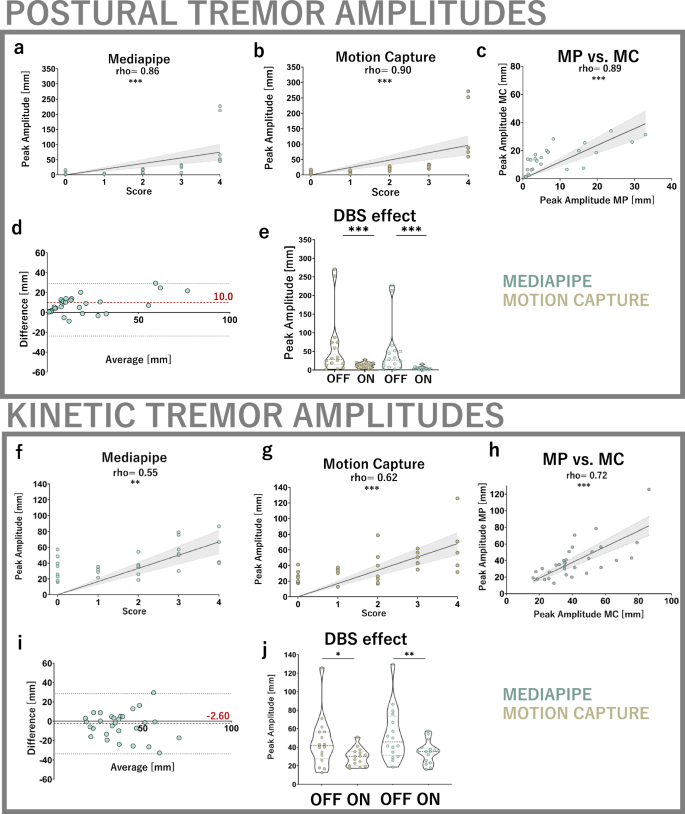基于视频的震颤分析计算机视觉算法的验证与应用
IF 12.4
1区 医学
Q1 HEALTH CARE SCIENCES & SERVICES
引用次数: 0
摘要
震颤是最常见的神经症状之一。由于其临床和神经生物学的复杂性,有必要采用新方法对其进行细致的表型分析。神经生理学仪器分析已被证明是有用的,但需要大量资源,而且缺乏广泛的可及性。与此相反,床旁评分操作简单,但缺乏精细度,无法捕捉到细微但相关的震颤特征。我们利用开源计算机视觉姿势跟踪算法 Mediapipe 来跟踪临床视频记录中的手,并利用由此产生的时间序列来计算典型震颤特征。在两个独立的临床队列中,该方法与基于标记的三维运动捕捉、腕戴式加速度测量、临床评分和第二种经过专门训练的震颤专用算法进行了比较。这些队列由 66 名确诊为本质性震颤的患者组成,在不同的任务条件和深部脑刺激治疗状态下进行评估。我们发现,Mediapipe 衍生的震颤指标与评分具有很高的临床收敛性(Spearman's ρ = 0.55-0.86,p≤ .01),震颤幅度和频率测量的准确度分别高达 2.60 毫米(95% CI [-3.13, 8.23])和≤0.21 赫兹(95% CI [-0.05, 0.46]),与黄金标准设备相匹配。Mediapipe(而非疾病专用算法)能够分析涉及手部复杂构型变化的视频。此外,它还能提取具有诊断和预后相关性的震颤特征,而这正是传统震颤评分所无法提供的。总之,这表明当前的计算机视觉算法可以转化为基于视频的震颤分析的准确且高度易用的工具,其结果可与金标准震颤记录相媲美。本文章由计算机程序翻译,如有差异,请以英文原文为准。


Validation and application of computer vision algorithms for video-based tremor analysis
Tremor is one of the most common neurological symptoms. Its clinical and neurobiological complexity necessitates novel approaches for granular phenotyping. Instrumented neurophysiological analyses have proven useful, but are highly resource-intensive and lack broad accessibility. In contrast, bedside scores are simple to administer, but lack the granularity to capture subtle but relevant tremor features. We utilise the open-source computer vision pose tracking algorithm Mediapipe to track hands in clinical video recordings and use the resulting time series to compute canonical tremor features. This approach is compared to marker-based 3D motion capture, wrist-worn accelerometry, clinical scoring and a second, specifically trained tremor-specific algorithm in two independent clinical cohorts. These cohorts consisted of 66 patients diagnosed with essential tremor, assessed in different task conditions and states of deep brain stimulation therapy. We find that Mediapipe-derived tremor metrics exhibit high convergent clinical validity to scores (Spearman’s ρ = 0.55–0.86, p≤ .01) as well as an accuracy of up to 2.60 mm (95% CI [−3.13, 8.23]) and ≤0.21 Hz (95% CI [−0.05, 0.46]) for tremor amplitude and frequency measurements, matching gold-standard equipment. Mediapipe, but not the disease-specific algorithm, was capable of analysing videos involving complex configurational changes of the hands. Moreover, it enabled the extraction of tremor features with diagnostic and prognostic relevance, a dimension which conventional tremor scores were unable to provide. Collectively, this demonstrates that current computer vision algorithms can be transformed into an accurate and highly accessible tool for video-based tremor analysis, yielding comparable results to gold standard tremor recordings.
求助全文
通过发布文献求助,成功后即可免费获取论文全文。
去求助
来源期刊

NPJ Digital Medicine
Multiple-
CiteScore
25.10
自引率
3.30%
发文量
170
审稿时长
15 weeks
期刊介绍:
npj Digital Medicine is an online open-access journal that focuses on publishing peer-reviewed research in the field of digital medicine. The journal covers various aspects of digital medicine, including the application and implementation of digital and mobile technologies in clinical settings, virtual healthcare, and the use of artificial intelligence and informatics.
The primary goal of the journal is to support innovation and the advancement of healthcare through the integration of new digital and mobile technologies. When determining if a manuscript is suitable for publication, the journal considers four important criteria: novelty, clinical relevance, scientific rigor, and digital innovation.
 求助内容:
求助内容: 应助结果提醒方式:
应助结果提醒方式:


